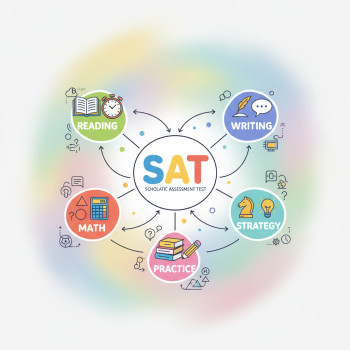Reading Your Digital SAT Practice Score Report: More Than Just a Number
When you first open a Digital SAT practice score report, your eyes probably zero in on the big three: Total Score, Reading & Writing, and Math. That’s natural—those numbers are the headline. But if you stop there, you’re missing the part of the story that turns practice into progress. The modern digital report is designed to be diagnostic: it shows not only how many questions you answered correctly, but where your strengths live, which types of mistakes cost you points, and what to study next.
Why practice test score reports matter
A practice test score report is like a friendly, data-rich coach. It translates raw performance into concrete, actionable feedback. Instead of guessing that you’re “bad at grammar” or “weak at algebra,” a good report identifies specific content domains and performance bands—so you can focus study sessions with surgical precision. Think of it as the difference between wandering through a library and having a curated reading list handed to you.
What the Report Shows (and How to Read Each Part)
Digital SAT practice reports include a few consistent elements. Each part plays a role in telling the full story of your performance.
1. Total and Section Scores
These are the big-picture indicators. Your Total Score combines Reading & Writing and Math. Section scores give you a sense of balance—do you lean stronger into textual reasoning or numbers? But remember: two students can have the same section score and very different profiles beneath the surface.
2. Percentiles and Comparisons
Percentiles tell you how your score stacks up against other test-takers. Reports often include multiple comparison groups, such as national percentiles and test-taker samples. Use percentiles to set realistic goals—are you aiming to move from the 60th to the 75th percentile, or to reach the 90th?
3. Knowledge & Skills (Domain) Breakdown
This is the gold. The digital report breaks Reading & Writing and Math into fine-grained content domains—typically four domains per section. For example, Reading & Writing might include Command of Evidence, Words in Context, Expression of Ideas, and Standard English Conventions. Math domains often separate Algebra & Functions, Problem Solving & Data Analysis, Geometry & Trigonometry, and Advanced Math.
Within each domain, the report places your performance into a band—ranging from foundational to advanced. This tells you what kinds of questions you could likely answer correctly and which require more practice.
4. Score Ranges and Measurement Error
Score reports provide a score range that reflects testing variability—your score could reasonably fall within that range if you took the test again. Use the range to decide whether a marginal score increase is meaningful. If your new score is within the same range, it may not represent real improvement; if it falls outside, you might be making measurable gains.
5. Question-Level Review (When Available)
Practice platforms often let you see each question: the correct answer, your answer, and an explanation. This level of detail helps identify careless mistakes versus conceptual gaps. On digital practice platforms, these item-by-item reviews are often integrated into a “My Practice” or “Bluebook” dashboard.
Turning Report Insights into a Smart Study Plan
Data is only as useful as the action it drives. After you read your report, here’s a step-by-step way to translate it into an effective study routine.
Step 1 — Identify the three biggest opportunities
Scan your domain bands and pick:
- One high-leverage weakness (e.g., Algebra: Linear Equations)
- One recurring careless-mistake pattern (e.g., arithmetic errors, misreading question stems)
- One moderate-strength you can reliably turn into a higher-scoring asset (e.g., Command of Evidence)
Step 2 — Add micro-goals and time blocks
Don’t study vague categories—set tiny, measurable goals. Example: “This week I’ll complete six targeted algebra problems, review solutions, and redo the ones I got wrong.” Block time on your calendar: two 45-minute focus sessions Tuesday and Thursday beats three unfocused hours on Sunday.
Step 3 — Mix targeted practice with full-length tests
Domain practice builds skills; full-length tests build stamina and timing. Alternate: two weeks of deep domain work, then a practice test to measure gains and update your plan. Use the new test’s report to recalibrate.
Examples: Interpreting Real-World Score Profiles
Here are three fictional but realistic student profiles and what the report would suggest they do next.
Profile A: The Fast & Sloppy Achiever
Score: 1300 (R&W 650, Math 650). Report shows strong domain mastery but many questions marked as careless (wrong choices with near-miss answers).
- Action: Slow the pacing on practice tests. Implement a two-pass strategy—answer easy items quickly, flag medium/hard items for a second pass. Do error logs focused on question-execution habits.
- Study focus: Timed accuracy drills, answer-check routines, and practice under slight distractions to simulate test pressure.
Profile B: The Content-Gap Student
Score: 1050 (R&W 520, Math 530). The Knowledge & Skills report shows low bands in specific math areas and in Words in Context.
- Action: Spend two weeks on targeted concept lessons for weak domains. Use scaffolded practice starting from basic problems up to test-level items.
- Study focus: Foundations first—short tutorials, concept maps, and incremental practice sets. Then timed sets to build fluency.
Profile C: The Balanced Improver Using Personalized Help
Score: 1200 (R&W 600, Math 600). Stronger performance in some domains and small gaps in others. The student pairs report insights with 1-on-1 tutoring to craft a tailored plan.
- Action: Use a tutor to convert domain feedback into a weekly practice schedule. Tutors can help surface hidden patterns in mistakes and provide accountability.
- Study focus: Blend individualized instruction on weak areas with independent practice. Many students find Sparkl’s personalized tutoring helpful here—expert tutors, tailored study plans, and AI-driven insights make study time more efficient.
How to Use Tables and Tracking to Measure Progress
Turning qualitative insights into quantitative progress makes improvement predictable. Use a simple tracking table to monitor week-to-week gains across domains.
| Week | Domain Focus | Practice Hours | Practice Test Score | Percentile | Notes / Next Steps |
|---|---|---|---|---|---|
| 1 | Algebra (Linear Equations) | 4 | 1180 | 70th | Missed sign errors; add daily arithmetic check routine |
| 3 | Reading: Command of Evidence | 3.5 | 1210 | 73rd | Improved inference skills; continue practice on parallel passage sets |
| 5 | Mixed Review + Practice Test | 6 | 1260 | 80th | Gains in timing and fewer careless errors |
This simple tracking structure makes your progress visible: which domain practice translated into score movement, and which habits remain stubborn.
Common Misreads and How to Avoid Them
Students often misunderstand parts of score reports. Here are three common pitfalls and how to avoid them.
Pitfall 1: Fixating on small score changes
Small changes within a score range can be noise. Look for movement beyond the reported score range before celebrating major improvement. Instead of celebrating every 10-point jump, focus on consistent error-type reduction and domain band improvement.
Pitfall 2: Treating percentiles as destiny
Percentiles are useful for context, but they don’t define your potential. Two students in the 70th percentile can have very different study needs. Use percentiles for goal-setting, not self-definition.
Pitfall 3: Ignoring timing and stamina
A strong content profile is necessary but not sufficient. If your report shows good domain knowledge but practice-test timing is weak, prioritize full-length sessions and pacing drills. Time management is a skill to practice, not an innate trait.
How Tutors and Personalized Programs Amplify Report Insights
Reports give you the roadmap; tutors and personalized programs help you take the trip efficiently. A knowledgeable tutor does three things well:
- Interprets report nuance—turning domain bands into lesson sequences.
- Provides targeted feedback on habits and test-taking strategies.
- Holds you accountable—ensuring practice is consistent and deliberate.
If you’re wondering how to combine report insights with coaching, consider a hybrid approach: use reports to identify specific weeks of domain work, then meet with an expert tutor (for example, Sparkl’s personalized tutoring) for guidance on technique, for tailored study plans, and for AI-driven insights that reveal hidden trends in your work.
Putting It Together: A 6-Week Example Plan
Below is a sample plan built from a typical practice report showing weaknesses in Algebra and Command of Evidence, and moderate careless mistakes.
Week 1–2: Foundations and Error Patterns
- Daily 45–60 minute focused sessions on algebra concepts from the report.
- Error log for every practice set: label each mistake as Conceptual, Careless, or Timing.
- One 90-minute full-section timed practice per week.
Week 3–4: Strategy and Mixed Practice
- Start mixed problem sets combining algebra and geometry to simulate section composition.
- Practice two 3/4-length sections under timed conditions to build pacing.
- Meet with a tutor for a 1-on-1 session to review persistent error types and set a mid-plan adjustment.
Week 5–6: Full-Length Tests and Final Polishing
- Take two full-length timed digital practice tests (one early in Week 5, one at the end of Week 6).
- Use the score reports to measure gains in target domains; refine focus for the last week.
- Gradually taper volume in the final 3–4 days before a test simulation to ensure mental freshness.
Practical Tips for Using Digital Platforms and Reports Effectively
- Download and archive your practice score reports so you can spot long-term trends.
- Compare domain bands across multiple tests to see if improvements stick.
- Use question-level reviews to create a ‘repeat wrong’ list—revisit those items until you can reliably get them correct.
- Practice under varied conditions—quiet, noisy, morning, evening—to build flexible readiness.
How to Know When to Seek Extra Help
Score reports can also help you decide when to ask for help. Consider tutoring if:
- Your score plateaus despite regular practice and changing strategies.
- You consistently underperform in timed sections compared with untimed practice.
- Your error log shows conceptual gaps you can’t close with independent study.
One-on-one tutoring can compress months of progress into weeks by focusing on the exact concepts and strategies revealed by your report. Many students find that a short, targeted tutoring plan—paired with disciplined practice—yields the best returns. Sparkl’s personalized tutoring, for example, emphasizes tailored study plans, expert tutors, and AI-driven insights to convert report findings into efficient practice routines.
Final Notes: Make Your Reports Work for You
Practice test score reports are tools—powerful ones—when used the right way. They are not verdicts; they are feedback. Start with curiosity, not fear. Read the domain breakdowns. Track trends. Make small, measurable goals. And when you need help, choose targeted support that respects the story your scores tell.
In the end, improvement on the Digital SAT is a combination of accurate diagnosis and disciplined treatment. Your practice score reports provide the diagnosis. Your study plan, practice discipline, and—if you choose it—personalized tutoring provide the treatment. Keep the process iterative: practice, review the report, adjust, and repeat. That cycle—guided by concrete report insights—is how steady progress becomes real score gains.
Now go open that latest practice report. Read it with curiosity. Choose three small, specific actions you’ll take this week based on what you find—and then do them. The numbers will follow.















No Comments
Leave a comment Cancel